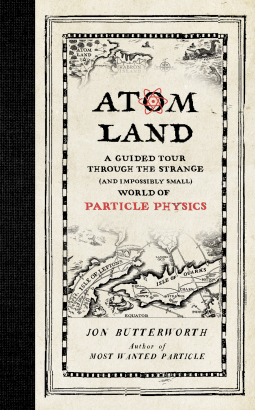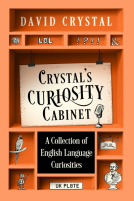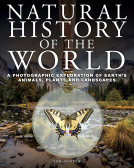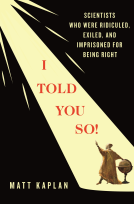
Atom Land
A Guided Tour Through the Strange (and Impossibly Small) World of Particle Physics
by Jon Butterworth
This title was previously available on NetGalley and is now archived.
Send NetGalley books directly to your Kindle or Kindle app
1
To read on a Kindle or Kindle app, please add kindle@netgalley.com as an approved email address to receive files in your Amazon account. Click here for step-by-step instructions.
2
Also find your Kindle email address within your Amazon account, and enter it here.
Pub Date Mar 20 2018 | Archive Date Apr 03 2018
Experiment, The | The Experiment
Description
For fans of Seven Brief Lessons on Physics and Astrophysics for People in a Hurry: a richly conjured world, in map and metaphor, of particle physics
Atom Land brings the impossibly small world of particle physics to life, taking readers on a guided journey through the subatomic world. Readers will sail the subatomic seas in search of electron ports, boson continents, and hadron islands. The sea itself is the quantum field, complete with quantum waves. Beware dark energy and extra dimensions, embodied by fantastical sea creatures prowling the far edges of the known world.
Your tour guide through this whimsical—and highly instructive— world is Jon Butterworth, leading physicist at CERN (the epicenter of today’s greatest findings in physics). Over a series of journeys, he shows how everything fits together, and how a grasp of particle physics is key to unlocking a deeper understanding of many of the most profound mysteries—and science’s possible answers—in the known universe.
Advance Praise
“A magnificent, compelling, and insightful voyage to the frontier of knowledge from a great writer with a deep understanding.”—Brian Cox, author of Why Does E=mc2?
Available Editions
| EDITION | Other Format |
| ISBN | 9781615193738 |
| PRICE | $19.95 (USD) |
| PAGES | 288 |
Average rating from 19 members
Featured Reviews
 Educator 253159
Educator 253159
My students really enjoyed my reading this aloud - we created maps on the board to go along with it, as I felt that it needed more visual aids. They liked how the concepts were brought down to their level and made them easier to understand. We will be getting a few copies in hardcover to keep in the school library.
Understanding particle physics through travel analogies
I enjoyed this book. There are lots of books on physics, but what sets this one apart is the liberal use of travel analogies to explain going from larger to smaller particles. I got the sense that author Jon Butterworth truly wanted me to understand the information and that created a writer-reader relationship. I can’t say that he was completely successful in getting me to understand, but he did create a fun-to-read book. And check out the footnotes. They are not to be missed. I recommend this book for anyone interested in science.
Disclosure: I received a complimentary copy of this book via Netgalley for review purposes.
Don't Worry About the "Whimsy"; This Is Top Drawer Teaching
I was a bit leery about this title at first. I have a working knowledge of physics and a reasonably broad understanding of the fundamentals of quantum physics. But, more and deeper understanding is always better, and it's one thing to sort of understand what you're reading and quite another to truly comprehend what you just read or at least to extend your reach. So, this book looked interesting - except for the come on -- "Readers will sail the subatomic seas in search of electron ports, boson continents, and hadron islands. The sea itself is the quantum field, complete with waves." Really?
Well, guess what. Dr. Butterworth makes this work. Our ship, (the particle), sails through the ocean, (making and encountering waves), and I'll be darned if the author doesn't turn this into the clearest, crispest, and most illuminating discussion of particle/wave issues that I've ever read.
For example, Butterworth describes the behavior of waves as they pass through a channel and enter a harbor. We learn about amplitude, frequency, and wavelength by watching seagulls bob up and down. We learn about diffraction by watching the wave spread out after exiting the channel and we learn about interference by watching two sets of waves cancel each other out. We then turn to the famous double slit experiment and see every single one of these principles and observations born out by the experiment, although this time our waves are made of light. The point is stunningly and memorably clear. But then we play around with frequency and energy and thus begin to understand the particle aspects of light. From there we use the ocean as a metaphor for the "quantum field", and that becomes clear as well.
At this point, even if you don't follow another word in the book, you will have begun to understand how quantum field theory "incorporates particle-like and wave-like properties into a new kind of object". You will begin to understand Feynman's "path integral", at which point you will be so pleased with yourself that you'll have to take a break and have a cup of tea just to calm down. And really, you've just started your journey. (O.K., so maybe that travel metaphor does work.)
Everything beyond this point is bonus time if you're a casual but motivated science reader. And to be honest, at some point before the end the reader's understanding may top out. (Don't test me on supersymmetry.) But before that we will learn about electrons, neutrons and protons, about why Dirac equations are so important, about bosons and fermions, muons, leptons, matter and anti-matter, hadrons and quarks. You'll learn about quantum chromodynamics and gluons, and how does gravity fit into all of this? For these topics we don't really rely on the ocean/atomland travel metaphor anymore, except as a generally useful way to introduce and organize topics, but the whole "atom land" frame doesn't get in the way either, so if it helps the reader more power to it.
My larger point is that this is one of the most useful, accessible, engaging, non-jargony, effective and yet modest teaching books I've seen. No celebrity scientist preening and no metaphysical blarney. This is a calm, earnest, patient, and authentically good natured effort to open the reader's mind. It was a tremendous and rewarding find.
(Please note that I received a free advance will-self-destruct-in-x-days Adobe Digital copy of this book without a review requirement, or any influence regarding review content should I choose to post a review. Apart from that I have no connection at all to either the author or the publisher of this book.)
 Andrew J, Reviewer
Andrew J, Reviewer
Atom Land was a joy to read.
I’m not a scientist, astronomer, physicist, etal. Just have a curious mind. Atom Land does a good job of helping those who are afraid of the Math in Physics. Being able to explain complex issues with simple illustrations is a gift. Jon Butterworth’s sailing voyage hit the mark for me. We come from the west, the land of what we consider normal. Planets, moons, suns, galaxies. This is what we see and interact with. Mr Butterworth then brings us to our starting point, Port Electron. Starting at Port Electron to give us a basic explanation of Waves and Particles to Atom Land, Isle of Lepton, Isle of Quarks, Hadron Island, Bosonia finally going to Far East. This is where Dark Matter and Dark Energy lives, extra dimensions, and things that are little more than guesses. But guesses lead to questions, questions to ideas of how to find out, then verification or failure. Then the process rolls on. How everything is connected and the journey we need to take back and forth to these differing regions may seem daunting but is well worth the investment in a cabin with a window.
There is very minimal amounts of Math. E=mc2 is an equation that many have heard, the ultimate consequences of that simple statement is still being explored. So we shouldn’t expect to walk away with profound insights but if you are interested you can use Atom Land as a jumping off point to take a more meaningful voyage into the creation of things.
Mr Butterworth is a teacher as well as a storyteller. I wholeheartedly recommend Atom Land
I wish to thank the Experiment Publisher, Jon Butterworth, and NetGalley for my ARC in exchange for my honest opinion and review.
For the past several years I've attended periodic public physics lectures at my alma mater. It's been over twenty years since I studied the subject and I never progressed past a general introduction. This book helps to refresh my memory and to reinforce the new-to-me material I've been learning about.
Atom Land provides an approachable overview to particle physics. The travel guide format makes the topic approachable; it allows the reader to digest the material in small chunks without being overwhelmed. I agree with other reviewers that while the no equations mantra is one intended to comfort the maths phobic, if they're written out in words you have the substance, please take the next step and write the style--the formula!
At the start of each section general maps are included to help orientate the reader and reinforce the travel guide theme. At times I found the travel metaphor forced but appreciate an attempt at a unique approach to a topic that has gained significant shelf space in the popular press. I think this is a useful book for those interested in particle physics. It is the sort of title I wish existed when I was a student and I'm appreciative of it now to help me understand current scientific discoveries.
Fantastic and approachable look into particle physics. Even though I am not a math or physics major- Butterworth still wrote this that was still understandable to me. There was just enough information to draw me in-and kept me wanting to get to the next chapter. The way Butterworth had used the concept of particle physics as a landscape really helped explain how beautiful and how creative he could be in making this accessible to someone who does not keep up with quantum physics.
Would highly recommend this one.
I received a copy of this book through NetGalley for an honest opinion. My thanks to Jon Butterworth, Netgalley and The Experiment for the opportunity to read and review this book.
 Tara S, Reviewer
Tara S, Reviewer
As a teacher in secondary school I'm always looking for books that can help me teach my core classes in new and interesting ways. This book does a great job of taking a complex subject and turning into something you actually want to read plus help create new lesson plans!
Readers who liked this book also liked:
Mart Kuldkepp
History, Nonfiction (Adult), Politics & Current Affairs


















